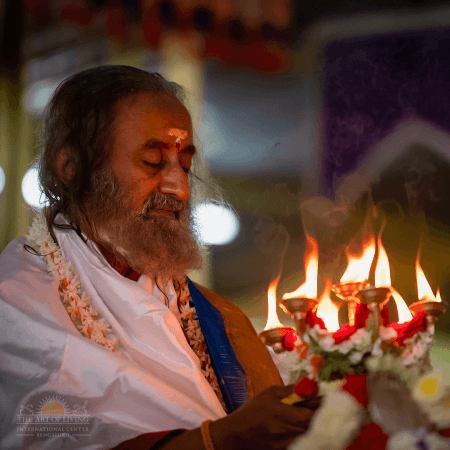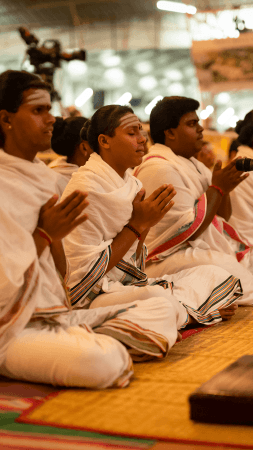As India has entered the grand festive season, people across the country are in a celebratory mood. Due to COVID-19 pandemic, the festivals haven't been the same in the last two years, but that changes now. From dandiya to garba and performing pujas to relishing delicacies, the Navaratri celebrations are a sight to behold. The Art of Living International Center also welcomed visitors for the first time in two years to join the grand Navaratri celebrations and it turned out to be a grand affair.
With more than 1.5 lakh visitors from 82 countries thronging AoL International Center in Bengaluru, it was a visually rich and spiritually uplifting experience. The celebrations witnessed special homas for world peace, meditation, chanting, singing and delicious food, the perfect recipe for a grand festive celebration.

Special homa ceremonies, including the ancient and powerful Chandi Homa organized on Maha Ashtami for peace and wellbeing in the world, were also performed on the occasion.
Navratri celebrations at Art of Living

As Art of Living celebrated Navratri, a soothing atmosphere was set. On Ashtami or the eighth day of Navaratri, Chandi Homa, which is known as the pinnacle of all homas, was performed. The sounds of ancient Vedic chants sung in unison by hundreds of priests filled up the atmosphere, as the aroma of the 108 herbs, fruits and other items being offered in the yagya ceremony wafted through the air.

The core of the ceremony involves a recitation of the Durga Saptashati or 700 verses in praise of the goddess Durga. With the recitation of each verse, offerings are made in the sacrificial fire invoking the goddess. Chandi Homa is also about recognizing the divinity in every form of life, from cattle to elephants, cows, grass, herbs, children, women, and men, among others.

"Chandi simply means very powerful. There is an herb associated with every mantra chanted during Chandi Homa and each mantra has its own power. It creates positive vibrations in the atmosphere," Gurudev Sri Sri Ravi Shankar, global peace leader and founder of The Art of Living, said.

Gurudev also said that the festival of Navratri celebrates the movement from speech to speechlessness, action to knowledge, and from narrow-mindedness to broad-mindedness. "Navratri is all about awakening the dormant divine consciousness in each one of us."

Maha Shashti, the sixth day, started with Ganapati Homa, which is done to remove obstacles and seek wisdom and blessings of Lord Ganesha in every walk of life. On Maha Saptami of the seventh day, Rudra Homa was performed, honoring Lord Shiva. This homa is performed to bring overall health, prosperity and happiness. Here, Lord Shiva is invoked in two kalashas in the form of Uma and Maheshwara, representing the masculine and feminine aspects of divinity.

One of the other key features of Navaratri celebrations is the special feast or Prasadam prepared by the Ashram Kitchen, which provides free meals to thousands every day. The kitchen served a whopping 1.5 lakh meals with 60 tons of rice, 40 tons of atta flour, 20 tons of dal, 40,000 litres of oil, 10-ton salt, 45000-litre milk, 250 tons of vegetables and 10,000-litre curd brought in for the mega feast.















